In today’s dynamic work environment, freelancing is no longer just a trend; it’s a viable career path for many. Whether you’re a seasoned professional looking for more flexibility or a newbie eager to break free from the traditional 9-to-5 grind, freelancing offers an exciting opportunity to be your own boss. But how do you start? This comprehensive guide will take you through every step on how to start as freelancer, from finding your niche to landing your first client.
9 Powerful Steps on How to Start as Freelancer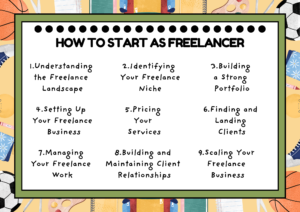
1. Understanding the Freelance Landscape
Freelancing, at its core, is a business model where individuals offer their services to clients on a project basis. Unlike traditional employment, freelancers are independent contractors, meaning they are responsible for their own taxes, benefits, and client acquisition. The rise of digital platforms has made it easier than ever to connect with clients worldwide, creating a booming gig economy.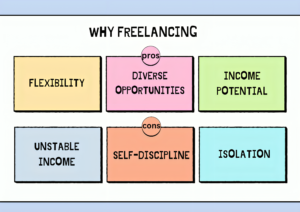
Why Freelancing?
- Flexibility: Choose your own hours and work from anywhere.
- Diverse Opportunities: Work on a variety of projects across industries.
- Earnings potential: Your income are immediately tied for your efforts.
Challenges of Freelancing
- Unstable Income: Work may not be consistent.
- Self-Discipline: You must manage your time and workload effectively.
- Isolation: Working alone can be lonely, especially if you’re used to a social office environment.
Understanding both the benefits and challenges of freelancing is crucial before taking the plunge.
2. Identifying Your Freelance Niche
One of the first steps to starting a freelance career is identifying your niche. Your niche is your area of expertise or the specific service you offer. It’s important to focus on what you’re passionate about and where your skills lie.
How to Find Your Niche:
Assess Your Skills:
Make a list of what you’re good at. This could range from graphic design, writing, coding, to digital marketing.
Consider Market Demand:
Research what services are in demand. Platforms like Upwork, Fiverr, and LinkedIn are good places to see what clients are looking for.
Combine Skills and Passion:
The sweet spot lies at the intersection of what you’re good at, what you love doing, and what the market needs.
For instance, if you’re passionate about writing and have experience in digital marketing, content writing for SEO could be a profitable niche. Specializing in a niche can make you stand out in a crowded marketplace.
3. Building a Strong Portfolio
A robust portfolio is your price ticket to attracting customers. It showcases your skills, experience, and style. When you’re just starting, building a portfolio might seem daunting, but with the right approach, it’s achievable.
Steps to Building a Portfolio:

Create Sample Work:
If you don’t have any client work to show, create samples. For example, write articles on trending topics, design mock logos, or develop a demo website.
Highlight Past Projects:
If you’ve worked in a related field before freelancing, include relevant projects. Employers from previous jobs might allow you to showcase work you did for them.
Show Diversity:
Include an expansion of work to demonstrate your versatility.
Use Testimonials:
If you’ve done any unpaid or volunteer work, ask for testimonials. Positive feedback, even from non-paying clients, can be very persuasive.
Make sure your portfolio is easy to navigate, visually appealing, and clearly showcases your strengths.
4. Setting Up Your Freelance Business
Now that you have a niche and a portfolio, it’s time to set up your freelance business. While freelancing offers flexibility, it’s essential to treat it like a business from the start.
Steps to Set Up:
Choose a Business Name:
Your business name can be your own name, a brand name, or something creative that reflects your niche. Ensure it’s unique and memorable.
Register Your Business:
Depending on your location, you might need to register your business as a sole proprietorship, LLC, or corporation. This step can also protect your personal assets and offer tax benefits.
Get Necessary Permits:
Some niches may require specific licenses or permits, so make sure you comply with local regulations.
Set Up a Business Bank Account:
Separate your personal and business finances to keep track of income and expenses.
Invest in Tools:
Freelancers need specific tools for productivity, project management, and communication. Consider investing in platforms like Trello, Slack, or Asana, and tools like Grammarly for writing or Canva for design.
5. Pricing Your Services
One of the biggest challenges for new freelancers is determining how to price their services. Price too high, and you might scare away clients; price too low, and you might undervalue your work.
How to Price Your Services:
Research Market Rates:
Study what different freelancers on your area of interest are charging. Sites like Upwork can provide insights into competitive pricing.
Consider Your Experience:
If you’re just starting, you might charge less than someone with years of experience. However, never underprice yourself to the point of devaluing your work.
Factor in Expenses:
Calculate your business expenses, such as software subscriptions, internet, office space, and taxes. Your rates should cover these costs and still provide a profit.
Choose a Pricing Model:
Decide whether you’ll charge hourly, per project, or on a retainer basis. Each model has its pros and cons. For instance, hourly rates are straightforward but might not reflect the value of your work. Project-based pricing can be more lucrative if you work efficiently.
Remember, pricing isn’t always set in stone. As you benefit revel in and build a reputation, you can step by step increase your quotes.
6. Finding and Landing Clients
With everything set up, it’s time to find clients. Building a client base can be the most challenging aspect of freelancing, especially in the beginning.
Where to Find Clients:

Freelance Platforms:
Websites like Upwork, Fiverr, and Freelancer are popular starting points. They offer access to a wide range of clients but can be competitive.
Social Media:
LinkedIn is particularly useful for freelancers. Join groups, participate in discussions, and share your portfolio.
Networking:
Attend industry events, webinars, and local meetups. Networking can lead to referrals and new clients.
Cold Pitching:
Identify companies that might need your services and reach out directly. Tailor your pitch to show how you could solve their unique issues.
Referrals:
Once you have a few clients, ask for referrals. Satisfied clients are often willing to recommend you to others.
Tips for Landing Clients:
Create a Compelling Pitch:
Your pitch need to simply articulate the fee you bring. awareness on how you could remedy the patron’s hassle.
Follow Up:
If you don’t hear back after a pitch, follow up after a week or two. Persistence can pay off.
Offer Free Consultations:
Offering a free consultation or audit can be a great way to demonstrate your expertise and build trust.
7. Managing Your Freelance Work
As a freelancer, you’re not just doing the work; you’re managing every aspect of your business, from client communication to invoicing.
Tips for Effective Management:
Set Clear Expectations:
From the start, communicate your terms, deadlines, and deliverables clearly with clients. A detailed contract is essential.
Use Project Management Tools:
Tools like Asana, Trello, or Notion help you keep track of tasks and deadlines. These platforms can also be shared with clients for better collaboration.
Stay Organized:
Keep your workspace tidy and your files organized. Use cloud storage solutions like Google power or Dropbox for clean get right of entry to.
Time Management: Use time-tracking apps like Toggl to manage your time efficiently. Avoid distractions and set a routine that maximizes productivity.
Invoicing:
Use invoicing software like FreshBooks or QuickBooks to send professional invoices. Set payment terms and follow up promptly on late payments.
Good management practices are crucial to maintaining a steady workflow and avoiding burnout.
8. Building and Maintaining Client Relationships
Long-term success as a freelancer depends on your ability to build and maintain strong client relationships.
How to Build Relationships:
Deliver Quality Work:
Always deliver quality work that meets or exceeds customer expectations.
Communicate Effectively:
Keep clients updated on your progress. Respond to emails and messages promptly.
Be Reliable:
Meet deadlines and honor your commitments. Reliability is a key factor in earning repeat enterprise.
Request Feedback:
After completing a project, ask for feedback. Use this to improve your services and build stronger relationships.
Show Appreciation:
A simple thank you could cross a long manner. Consider sending a note or small gift during the holidays to show your appreciation.
Happy clients are more likely to provide referrals and repeat business, which are vital to sustaining your freelance career.
9. Scaling Your Freelance Business
As you grow your freelance business, you may want to scale to increase your income or reduce your workload. Scaling can involve various strategies, from raising your rates to hiring other freelancers.
How to Scale:
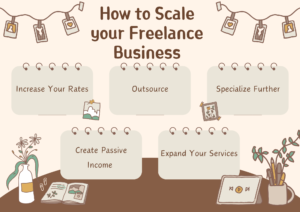
Increase Your Rates:
As your experience and reputation grow, enhance your costs. This is a straightforward way to increase your income without taking on more work.
Outsource:
If you have more work than you can handle, consider outsourcing parts of a project to other freelancers. This allows you to take on larger projects without becoming overwhelmed.
Specialize Further:
Narrowing your niche even further can allow you to charge premium prices for highly specialized work.
Create Passive Income:
Consider creating digital products, like eBooks, courses, or templates, that can generate income without requiring your constant involvement.
Expand Your Services :
If you’re a writer, consider offering editing services. If you’re a designer, offer branding packages. Expanding your services can attract more clients and diversify your income streams.
Scaling is about working smarter, not harder, and ensuring your business continues to grow sustainably.
Conclusion:
Starting as a freelancer can be an exciting and rewarding journey, but it’s not without its challenges. From identifying your niche to managing clients and scaling your business, freelancing requires dedication, discipline, and a proactive approach. By following the steps mentioned on this manual, you’ll be nicely for your way to constructing a a hit freelance career.
Freelancing offers the freedom to pursue your passions on your terms, and with the right mindset and tools, you can turn your skills into a thriving business. Whether you’re just starting or looking to take your freelance career to the next level, remember that success comes from a blend of perseverance, adaptability, and a commitment to continuous learning. Your freelance career is what you make of it—so start today, and shape the future you want.
This comprehensive guide is designed to equip aspiring freelancers with the knowledge and tools needed to start and grow a successful freelance business. Remember, every successful freelancer started with a single step—let this guide be yours.




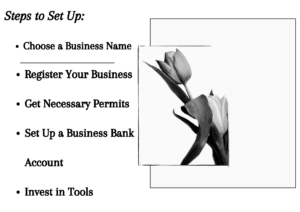
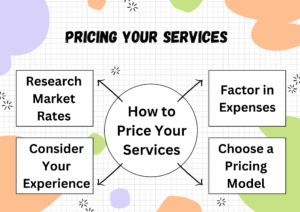
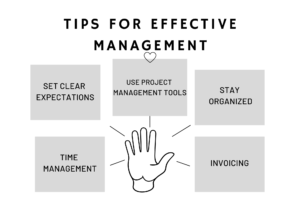
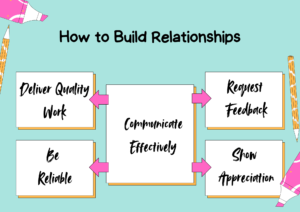








Leave A Comment